Tel Ashdod
North Tel Ashdod excavation – summary of two seaso
Institution: IAA
Excavators:
Elena Kogan ZahaviPerchia Nahshoni
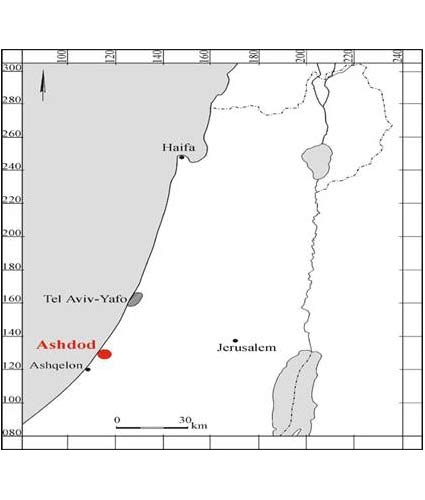 |
Plan
|
Rescue excavation, which was carried out by the Israel Antiquities Authority (IAA) under management of Elena Kogan Zahavi (first season) and Elena Kogan Zahavi and Perchia Nahshoni (second season), found evidence of Assyrian presence in Tel Ashdod. The site is located some 200 m north of Tel Ashdod and its area is about 10 dunams.
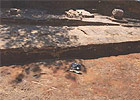 |
Area C
|
Historical background
Following the expansion of Assyrian Empire to our region (734 – 627 BC) Philistia in general and Ashdod in particular became a target for Assyrian armies for its economic status as a coastal city with a nearby port (Ashdod Yam) and strategic location on the sea route to Egypt.
From the Bible and written Assyrian source we know about two uprisings in Ashdod against the Assyrian occupation that happened in the period of Assyrian king Sargon II (722 – 705 BC). Following the uprisings Ashdod was conquered and made Assyrian vassal city-state headed by an Assyrian governor.
Where was the governor's residence?
Excavations carried out by professor Moshe Dotan found evidence of destruction of Ashdod by the Assyrians, but no trace of their construction.
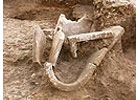 |
stone basin
|
Excavation description
Four excavation areas (A,B,C,D) exposed a large structure which we relate to a palace from the Assyrian period.
Layer 5: Exposed remains of a structure built in typical Assyrian style. The building stands on a podium made of square sun dried bricks. The walls are made of square bricks and are some 3 m thick. Some kiln fired bricks were found in the ruins.
In area C we exposed remains of podium and wall that enclosed the palace from the west (fig. 2). The remains were in bad condition due to peneplain. A test section west of the wall showed a moat that was dug out for defense in this direction.
East to the wall and north-west to the structure we found the most surprising discovery of this excavation – three basins in two partly exposed rooms.
The floor and walls of the eastern room was plastered and on west side we found a plastered niche with terracotta basin.
The western room revealed two more basins on plastered floor. One of the basins was made of terracotta . The second basine was made of stone and plastered inside. There were signs of ruination in the rooms end the basins were moved from their original places. It is possible that the rooms were bathrooms and the basins were used as bathtubs although similar basins were used in Assyria as coffins for burial.
In area A south of area C we exposed a large yard (in north area), possibly square in shape (30 m from north to south) which was built on manmade landfill. West of the yard we found parts of two elongated rooms positioned in east-west direction. South of the yard there were more halls or rooms built on a podium.
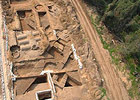 |
Area A
|
In area B north of area A we exposed the wide brick wall positioned east-west built on a podium. On north this wall approached by other walls from the north which enclosed elongated rooms. The rooms evidently were used for storage at the basement level of the palace. The rooms were made of mud walls 1.2 m thick built on a podium. Walls of 4 rooms could be noticed of which one was completely excavated and found devastated by fire.
The small finds included various ceramics among them some utensils typical to Assyrian palaces, terracotta figurine and terracotta mould of figurine and metal utensils.
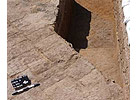 |
Area B
|
Layer 4: This layer relates to the period of activity and building following destruction of the palace In areas C and D . We discovered remains of buildings and walls based on foundations made of stones and dirt floors. The walls were preserved only to the plinth level. The finding included numerous ceramics on the floors dated to 8 th– 7 th century.
Layer 3: A finding from the Persian period dated the remains on this level. Preservation was very poor due to construction in the Hellenistic period.
In area B the Persian findings were discovered only in the rubbish pits. In the area C we found part of a stone wall foundation directed from east to west and a hole which was apparently used for archives. In the hole we found ceramics fragments of ritual pedestal with integrated male and female images and two imported lekythoi.
Layer 2: This layer was dated to the Hellenistic period. It included fragmented remains of buildings, which did not enable us to understand the whole complex.
In the area B we found remains of walls in two stages directed from east to west. In both stages we exposed floors approaching each wall. Ceramics and coins found on the floors were dated to the Hellenistic period. We also found a rubbish pit from the same period.
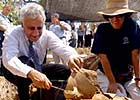 |
The president of Israel Mr. Katsav with the archeologist E.Kogan Zahavi
|
In the area C we found a wall section directed from east to west (wall 101 on the left). Approached by a floor and water ditch built east of the wall. The water ditch was not connected to the wall. The find included numerous ceramics.
In the area A, south of the site we found five kilns that were excavated in the previous seasons (two of the kilns were excavated by Daniel Varga of IAA, southern district).
Layer 1: This layer relates to a vaulted grave in southern side of Area A (fig 2). The grave was cast as one concrete block into a large pre-made hole and only its face was exposed above the ground. The grave comprised of one central vaulted room and six burial niches on two of its sides. The grave was not excavated due to objections from the Ministry of Religious Affairs. A similar grave that was excavated in Ashkelon was dated to 200 -300 AD. The grave construction ruined a brick wall of an Assyrian building. Two ark graves made of stone and covered with stone plates were found east of the vaulted grave. The graves were not excavated.